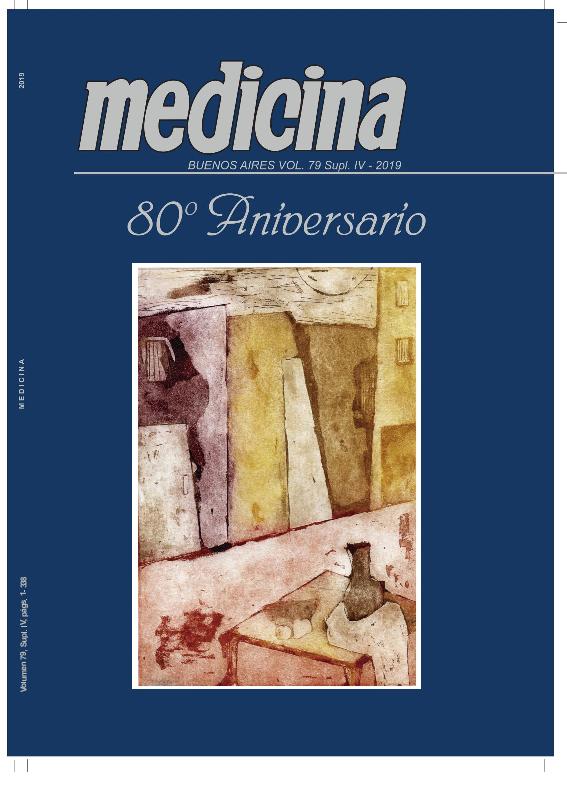Mostrar el registro sencillo del ítem
dc.contributor.author
Scarcella, Silvana Andrea

dc.contributor.author
Solana, María Victoria

dc.contributor.author
Bianco, Florencia

dc.contributor.author
Solana, Hugo Daniel

dc.contributor.author
Lombardo, Daniel Marcelo

dc.date.available
2022-09-05T10:00:29Z
dc.date.issued
2019
dc.identifier.citation
Histological demonstration of apoptosis activation in the liver fluke (Fasciola hepatica) following Closantel treatment of experimentally-infected sheep; LXIV Reunión Anual de la Sociedad Argentina de Investigación Clínica; LI Reunión Anual de la Asociación Argentina de Farmacología Experimental; XXI Reunión Anual de la Sociedad Argentina de Biología; XXXI Reunión Anual de la Sociedad Argentina de Protozoología; IX Reunión Anual de la Asociación Argentina de Nanomedicinas y VI Reunión Científica Regional de la Asociación Argentina de Ciencia y Tecnología de Animales de Laboratorio; Mar del PLata; Argentina; 2019; 186-186
dc.identifier.issn
1669-9106
dc.identifier.uri
http://hdl.handle.net/11336/167269
dc.description.abstract
The apoptosis can be by DNA damage, cytokine expression, etc. The study of apoptosis has application for the understanding of biological events, such as the tumorogenesis,the action mechanism to drugs, etc. For the apoptosis detection in differentcell lines and tissues there are methods such as TdT-mediated dUDP nick endlabelling (TUNEL) or directly the immunolocalization of Caspase-3. Closantel is an antiparasitic halogenated salicilanilide for the treatment of Fasciola hepatica infestation in farm animals. Its action mechanism is not fully known. It´s known decouple the oxidative phosphorylation but the probable degree of contribution of apoptosis. In this work, were used the Caspase-3 detection and TUNEL techniques to assess the probable involvement of the closantel in the generation of apoptosis in Fasciola hepatica. Fourteen lambs were infected orally with 200 metacercariae of Fasciola hepatica. At 16 weeks post-infection, 10 lambs were treated orally with closantel (10mg/kg.). Adult flukes were recovered from the liver of individual lambs at 0h (notreated n:4), 24h (n:5) and 36h (n:5) post treatment. The flukes were processed for usual histological analysis. There were no injuries at the controls. The F. hepatica at 24 h PT showed minor damage to the posterior end of syncytium. Those of 36 h PT lost large areas of the syncytium in the posterior and dorsal end with cell depletion in testis and vitelline follicles and the oocytes appear rounded with condensed cytoplasm, indicating apoptosis. In testis, ovary and vitelline follicles, defects in closantel-treated trematodes were aligned with failure inthe energy-demanding processes of mitosis and differentiation. These changes could be attributed to anthelmintic-induced blockage of intermediary metabolismand neuromuscular paralysis. This work confirm that closantel activates apoptosis being too this phenomenon its mechanism of action.
dc.format
text/plain
dc.language.iso
eng
dc.publisher
Fundación Revista Medicina
dc.rights
info:eu-repo/semantics/openAccess
dc.rights.uri
https://creativecommons.org/licenses/by-nc-sa/2.5/ar/
dc.subject
FASCIOLA HEPATICA
dc.subject
CLOSANTEL
dc.subject
APOPTOSIS
dc.subject.classification
Ciencias Veterinarias

dc.subject.classification
Ciencias Veterinarias

dc.subject.classification
CIENCIAS AGRÍCOLAS

dc.title
Histological demonstration of apoptosis activation in the liver fluke (Fasciola hepatica) following Closantel treatment of experimentally-infected sheep
dc.type
info:eu-repo/semantics/publishedVersion
dc.type
info:eu-repo/semantics/conferenceObject
dc.type
info:ar-repo/semantics/documento de conferencia
dc.date.updated
2022-08-30T18:13:46Z
dc.journal.volume
79
dc.journal.number
4
dc.journal.pagination
186-186
dc.journal.pais
Argentina

dc.journal.ciudad
Buenos Aires
dc.description.fil
Fil: Scarcella, Silvana Andrea. Consejo Nacional de Investigaciones Científicas y Técnicas. Centro Científico Tecnológico Conicet - Tandil. Centro de Investigación Veterinaria de Tandil. Universidad Nacional del Centro de la Provincia de Buenos Aires. Centro de Investigación Veterinaria de Tandil. Provincia de Buenos Aires. Gobernación. Comision de Investigaciones Científicas. Centro de Investigación Veterinaria de Tandil; Argentina
dc.description.fil
Fil: Solana, María Victoria. Consejo Nacional de Investigaciones Científicas y Técnicas. Centro Científico Tecnológico Conicet - Tandil. Centro de Investigación Veterinaria de Tandil. Universidad Nacional del Centro de la Provincia de Buenos Aires. Centro de Investigación Veterinaria de Tandil. Provincia de Buenos Aires. Gobernación. Comision de Investigaciones Científicas. Centro de Investigación Veterinaria de Tandil; Argentina
dc.description.fil
Fil: Bianco, Florencia. Consejo Nacional de Investigaciones Científicas y Técnicas. Centro Científico Tecnológico Conicet - Tandil. Centro de Investigación Veterinaria de Tandil. Universidad Nacional del Centro de la Provincia de Buenos Aires. Centro de Investigación Veterinaria de Tandil. Provincia de Buenos Aires. Gobernación. Comision de Investigaciones Científicas. Centro de Investigación Veterinaria de Tandil; Argentina
dc.description.fil
Fil: Solana, Hugo Daniel. Consejo Nacional de Investigaciones Científicas y Técnicas. Centro Científico Tecnológico Conicet - Tandil. Centro de Investigación Veterinaria de Tandil. Universidad Nacional del Centro de la Provincia de Buenos Aires. Centro de Investigación Veterinaria de Tandil. Provincia de Buenos Aires. Gobernación. Comision de Investigaciones Científicas. Centro de Investigación Veterinaria de Tandil; Argentina
dc.description.fil
Fil: Lombardo, Daniel Marcelo. Universidad Nacional del Centro de la Provincia de Buenos Aires. Facultad de Ciencias Veterinarias. Laboratorio de Biología Celular y Molecular; Argentina
dc.relation.alternativeid
info:eu-repo/semantics/altIdentifier/url/https://protozoologia.org.ar/wp-content/uploads/REV-MEDICINA-REUNION-2019.pdf
dc.conicet.rol
Autor

dc.conicet.rol
Autor

dc.conicet.rol
Autor

dc.conicet.rol
Autor

dc.conicet.rol
Autor

dc.coverage
Nacional
dc.type.subtype
Reunión
dc.description.nombreEvento
LXIV Reunión Anual de la Sociedad Argentina de Investigación Clínica; LI Reunión Anual de la Asociación Argentina de Farmacología Experimental; XXI Reunión Anual de la Sociedad Argentina de Biología; XXXI Reunión Anual de la Sociedad Argentina de Protozoología; IX Reunión Anual de la Asociación Argentina de Nanomedicinas y VI Reunión Científica Regional de la Asociación Argentina de Ciencia y Tecnología de Animales de Laboratorio
dc.date.evento
2019-11-13
dc.description.ciudadEvento
Mar del PLata
dc.description.paisEvento
Argentina

dc.type.publicacion
Journal
dc.description.institucionOrganizadora
Sociedad Argentina de Investigación Clínica
dc.description.institucionOrganizadora
Asociación Argentina de Farmacología Experimental
dc.description.institucionOrganizadora
Sociedad Argentina de Biología
dc.description.institucionOrganizadora
Sociedad Argentina de Protozoología
dc.description.institucionOrganizadora
Asociación Argentina de Nanomedicinas
dc.description.institucionOrganizadora
Asociación Argentina de Ciencia y Tecnología de Animales de Laboratorio
dc.source.revista
Medicina (Buenos Aires)

dc.date.eventoHasta
2019-11-16
dc.type
Reunión
Archivos asociados
